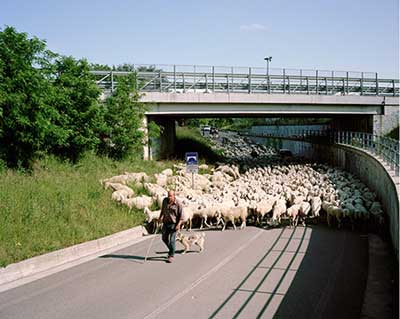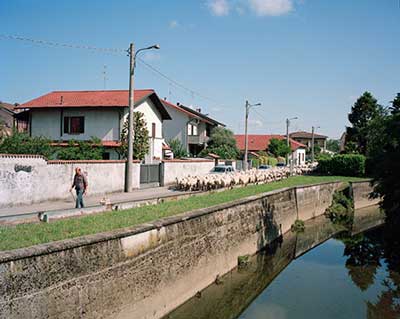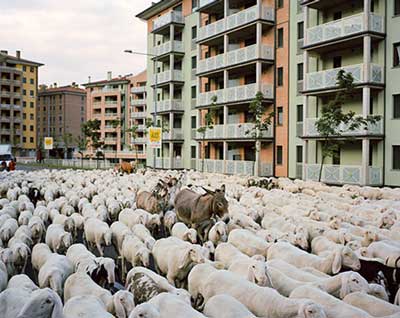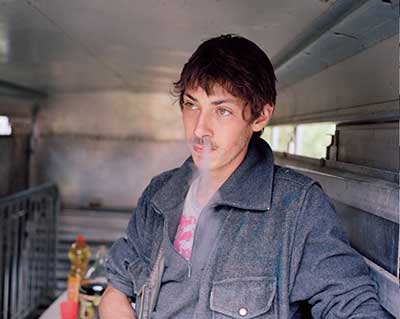Commissioned by Photomonitor
Published 16.01.2018
Transumanza: Italian Pastoral © Stefano Carnelli
The full title of Stefano Carnelli’s monograph, Transumanza: Italian Pastoral invites an analysis of the project alongside an inspection of the term ‘pastoral’ – a pillar within the discourse of landscape representation, yet multifaceted and poorly understood. Whilst the word is frequently used pejoratively, alluding to a sentimental and idealised representation of rural life, this does the pastoral a disservice. In one of its earliest forms, such as Virgil’s satirical sketches to be found in his Eclogues (c. 40 BC), the pastoral mode reveals its potential for, as William Empson described, the ‘process of putting the complex into the simple’[1]. Often using the voice of the humble shepherd, the pastoral uses such rustic figures, or nature itself, to speak of social concerns of the period, within narratives around confrontations between a virtuous rural existence and the wretched ways of the city and its politics.
Transumanza: Italian Pastoral © Stefano Carnelli
A simpler definition of a pastoral however is provided within Leo Marx’s remark, ‘No shepherd, no pastoral’[2]. In Transumanza Carnelli’s followed a number of shepherds in Lombardy, northern Italy, who continue ancient pastoralist practices of herding their sheep from higher altitudes to more temperate climates in the winter, and then retrace their journey into the mountains in the spring. It is estimated that only 60 shepherds in this region continue this practice today, the majority of whom transport their flocks in trucks rather than by foot. These journeys intersect towns and villages, and also distinctly less rural scenery such as supermarket carparks, industrial estates and abandoned factory compounds. The final few images in the book show the sheep within the more typical agrarian landscape of Alpine foothills, but the narrative starts with pristine stock bathed in morning light striding through a thoroughfare in an indistinct business district.

Transumanza: Italian Pastoral © Stefano Carnelli
Carnelli’s straightforward documentary approach, occasionally capitalizing on more luxurious lighting situations, distances the work from the widespread understanding of the pastoral as the creation of an idealised image of rural life. The constant juxtaposition of the agricultural with the urban throughout the book provides an abundance of incongruent, amusing, and almost anachronistic imagery that subverts pastoral stereotypes. Carnelli’s photographs tend to be taken closely amongst the sheep and the shepherds, but he often steps back a little further, and consciously references traditional, pictorial landscape composition, updating the scenery. In addition to the topography there is close observation of the realities of the shepherds’ lifestyles during these periods of herding, such as their stiff socks and underwear drying on a makeshift washing-line attached to a dilapidated caravan – a far cry from the kind of ‘shepherd’s hut’ one might find as a garden office or studio, or listed at an extortionate price on Airbnb.

Transumanza: Italian Pastoral © Stefano Carnelli
The antagonism we see in the constant invasion of the urban by these shepherds and their flocks underscores literary definitions of a pastoral work, as something which expresses a contrast between urban and rural life. If the project attempts to be considered as a pastoral narrative beyond this more superficial definition, and perhaps place itself within the political satire of the Virgilian sense of a pastoral narrative, then it is appropriate to ask what social and political complexities Carnelli might be attempting to articulate through his series: We are perhaps invited to consider for how much longer this ancient agricultural practice will continue in this region, with knowledge of specific routes exchanged from generation to generation likely to soon be lost to bureaucracy and agricultural regulation. But Carnelli’s photographs are very much rooted to here and now – vehicles, billboards and architecture in his pictures connect us to the present climate. And as such, it is difficult not to be reminded of current uncertainties around the movement of people in Europe, and the much more desperate migration crises globally.

Transumanza: Italian Pastoral © Stefano Carnelli
__________
[1] Empson, William. 1935. Some Versions of Pastoral. London: Chatto & Windus [23]
[2] Marx, Leo. 1986. ‘Pastoralism in America.’ In Ideology and Classic American Literature. Ed. Sacvan Bercovitch and Myra Jehlen. Cambridge University Press. 36-69 [45]
Published by Peperoni Books, £36.00, ISBN 978-3-941249-06-6


